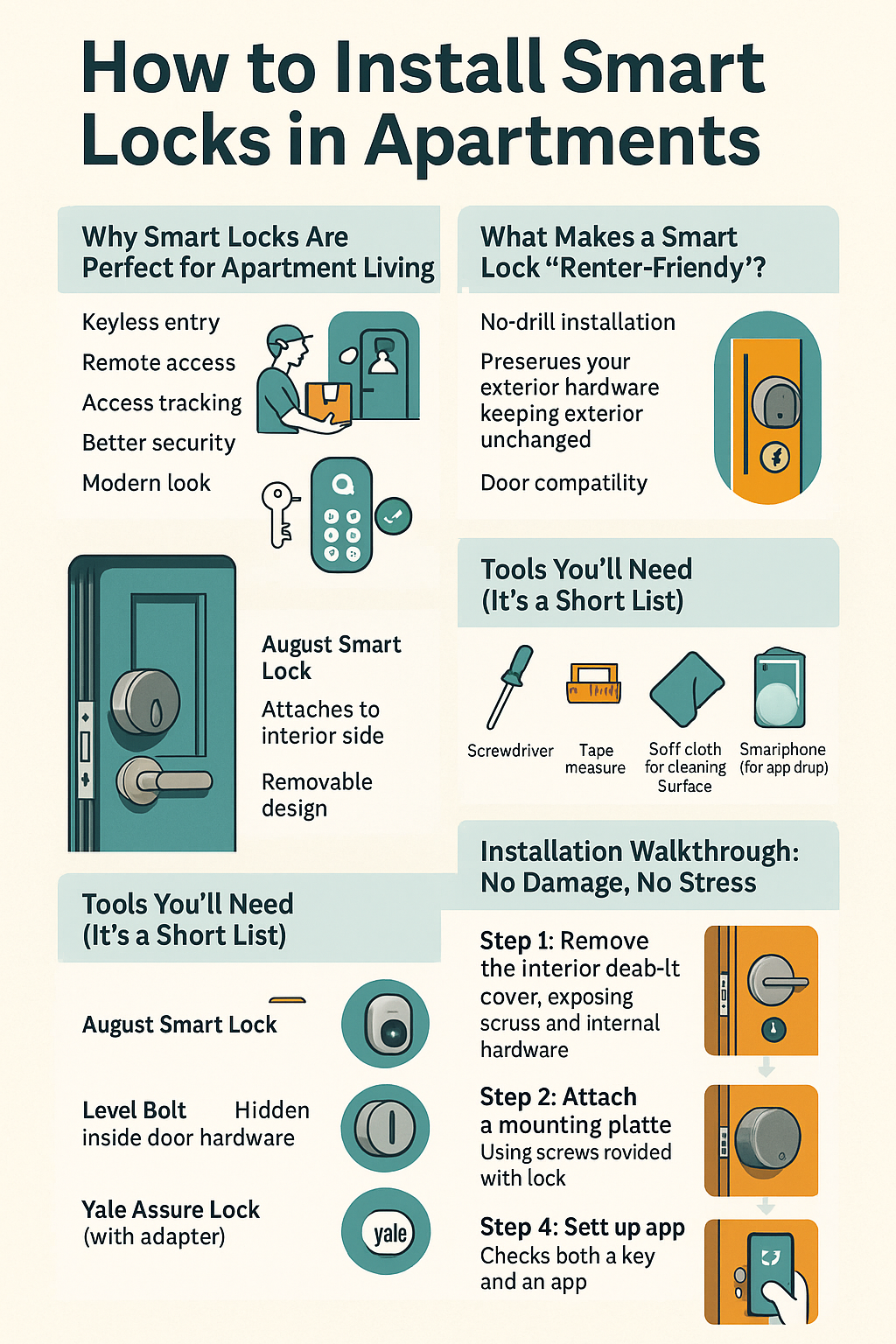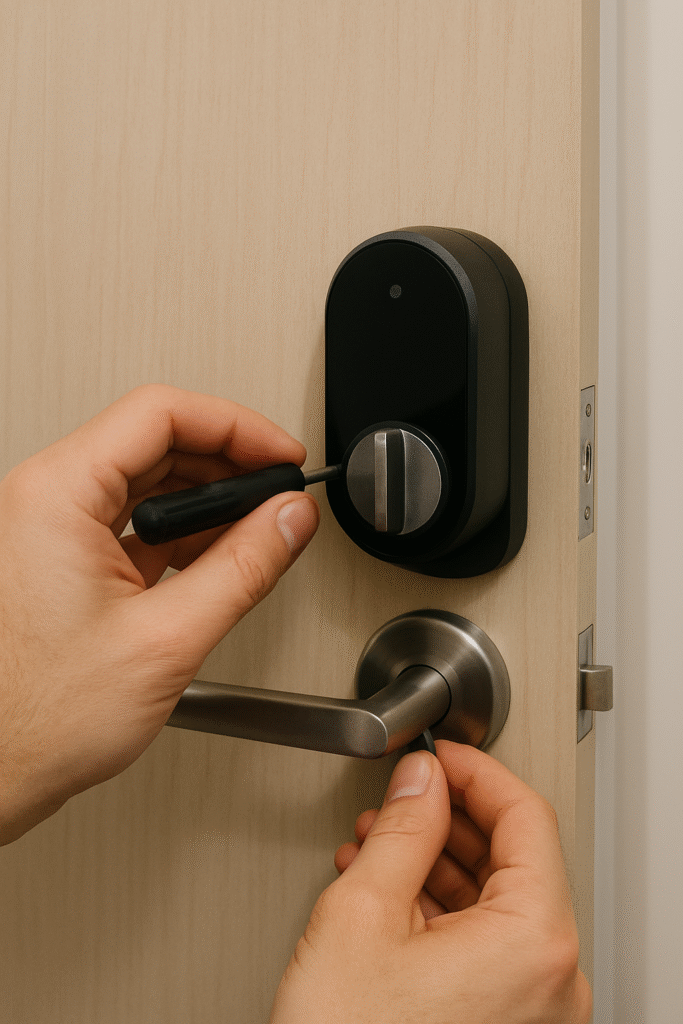Moving into a new apartment can feel like a fresh start—until you notice the outdated deadbolt on your front door. You want the convenience and security of a smart lock, but there’s a catch: your lease doesn’t allow drilling, permanent changes, or hardware replacements.
The good news? You don’t need to be a homeowner to upgrade your lock. With the right smart lock and a few simple steps, you can enjoy keyless living, remote control, and extra security—without risking your security deposit.
This guide walks you through everything you need to know about installing a smart lock in your apartment safely, legally, and without tools.

Why Smart Locks Are Perfect for Apartment Living
Smart locks are more than a modern convenience—they solve real problems renters face every day.
Here’s what makes them ideal for apartment dwellers:
- Keyless entry: No more fumbling with keys when your hands are full.
- Remote access: Let in guests, delivery drivers, or cleaners from your phone.
- Access tracking: See who unlocked the door and when.
- Better security: Create and delete temporary codes as needed.
- Modern look: A smart lock instantly updates the feel of your entryway.
It’s like swapping out an old flip phone for a smartphone. The core function is the same, but the experience is completely different.
What Makes a Smart Lock “Renter-Friendly”?
Not every smart lock is a good match for rental living. The ideal lock should be non-invasive, easy to install, and just as easy to remove when you move out.
Look for these features:
- No-drill installation – Uses your existing deadbolt and screw holes.
- Preserves your exterior hardware – Your landlord still sees the original lock.
- Removable design – Take it with you when your lease ends.
- Door compatibility – Check your door’s thickness and deadbolt size to ensure a fit.
Recommended Smart Locks for Renters
- August Smart Lock – Attaches to the interior side of your existing deadbolt.
- Level Bolt – Hidden inside the door hardware, keeping the exterior unchanged.
- Yale Assure Lock (with adapter) – Ideal for keypad fans, installs without drilling.
Tools You’ll Need (It’s a Short List)
Installing a renter-safe smart lock is refreshingly simple. In most cases, you don’t even need a full toolbox.
You may need:
- A screwdriver
- Tape measure
- Soft cloth for cleaning the surface
- Your smartphone (for app setup)
You won’t need:
- A drill
- A hammer
- Wall anchors
- Your landlord’s permission
Before You Install: Prep the Door
A few small steps will make installation smoother and help avoid issues later.
- Clean the surface – Wipe down the area where the lock will mount.
- Test the deadbolt – It should lock and unlock easily without sticking.
- Measure carefully – Confirm that the smart lock fits your existing setup.
- Install fresh batteries – Most models use AA or lithium batteries. Start with a new set.
Installation Walkthrough: No Damage, No Stress
Here’s how to install a smart lock without damaging your door, using the August Smart Lock as an example.
Step 1: Remove the interior deadbolt cover
This exposes the screws and internal hardware. Leave the exterior part intact.
Step 2: Attach the mounting plate
Use the screws provided with your lock. No drilling required.
Step 3: Connect the smart lock
Slide or snap the smart lock onto the mounting plate, following the instructions in the app.
Step 4: Set up the app
Download the manufacturer’s app and follow the guided setup. You’ll pair the lock with your phone, calibrate it, and create access options.
Step 5: Test it
Use both your key and the app to test the lock. Make sure everything opens and closes smoothly.
Pro tip: If your lock uses adhesive backing, wipe the surface with rubbing alcohol before applying. It helps the adhesive stick securely.
Exploring Smart Lock Options for Renters
Depending on your preferences and priorities, there are a few styles to choose from:
Keypad Smart Locks
Shareable entry codes make these great for guests or roommates. Ideal if you don’t always want to rely on your phone.
Fingerprint Smart Locks
Fast, secure, and convenient. Make sure the model you choose is weather-rated if your door is exposed.
Wi-Fi and Bluetooth Smart Locks
- Wi-Fi: Allows remote access from anywhere, real-time alerts, and app control.
- Bluetooth: Doesn’t require internet but has limited range. Works well for local, offline control.
Setup Tips for Smarter Living
Once installed, your smart lock can do a lot more than just unlock the door.
If you’re using a Wi-Fi model:
- Connect it to a reliable home network.
- If the signal is weak near the door, use a Wi-Fi extender.
For Bluetooth locks:
- Keep Bluetooth turned on for features like auto-unlock.
- Make sure the app is allowed to run in the background.
Smart home integration:
- Many locks work with Amazon Alexa, Google Home, and Apple HomeKit.
- Create voice commands, routines, or automations like locking the door at night.
Don’t Skip These Security Settings
Even the best hardware is only as secure as the way it’s used. After setup, review these important safety features:
- Two-factor authentication – Adds a second layer of protection.
- Access codes – Create temporary or scheduled codes for cleaners, guests, or deliveries.
- Audit trail – Review who accessed your home and when.
- Automatic lock – Set the door to lock automatically after a certain time.
Ongoing Maintenance Tips
Smart locks are low-maintenance, but a few habits will help avoid issues:
- Replace the batteries every 6–12 months or when prompted.
- Keep the exterior and sensors clean with a soft cloth.
- Avoid slamming the door—it can misalign the lock or internal mechanism.
- Check for firmware updates via the app. These often include new features or security improvements.
Common Issues (and Easy Fixes)
Lock isn’t responding
Check or replace the batteries.
Wi-Fi keeps disconnecting
Try moving your router closer or installing a Wi-Fi extender.
Auto-lock feature stopped working
Recalibrate the lock through the app.
The app won’t recognize the lock
Reset the lock following the manufacturer’s instructions, then re-pair it.
Real Example: How One Renter Upgraded Without Breaking the Rules
Sam, a freelance designer in a fifth-floor walkup, wanted to give his cleaner access without hiding a key under the mat. His lease didn’t allow door modifications, and his landlord was strict.
His solution?
He installed an August Smart Lock on the interior side of his door. It didn’t alter the exterior or require any drilling. He used app-generated access codes for his cleaner, and the landlord never noticed a thing.
Smart lock, smarter approach.

Final Thoughts: Yes, Renters Can Use Smart Locks Too
You don’t have to be a homeowner to enjoy modern security. With the right smart lock, you can upgrade your apartment entry without breaking rules, damaging hardware, or risking your deposit.
If you’re tired of keys and want the freedom of secure, keyless entry—this is your sign.
Start small. Install smart. Live secure.
